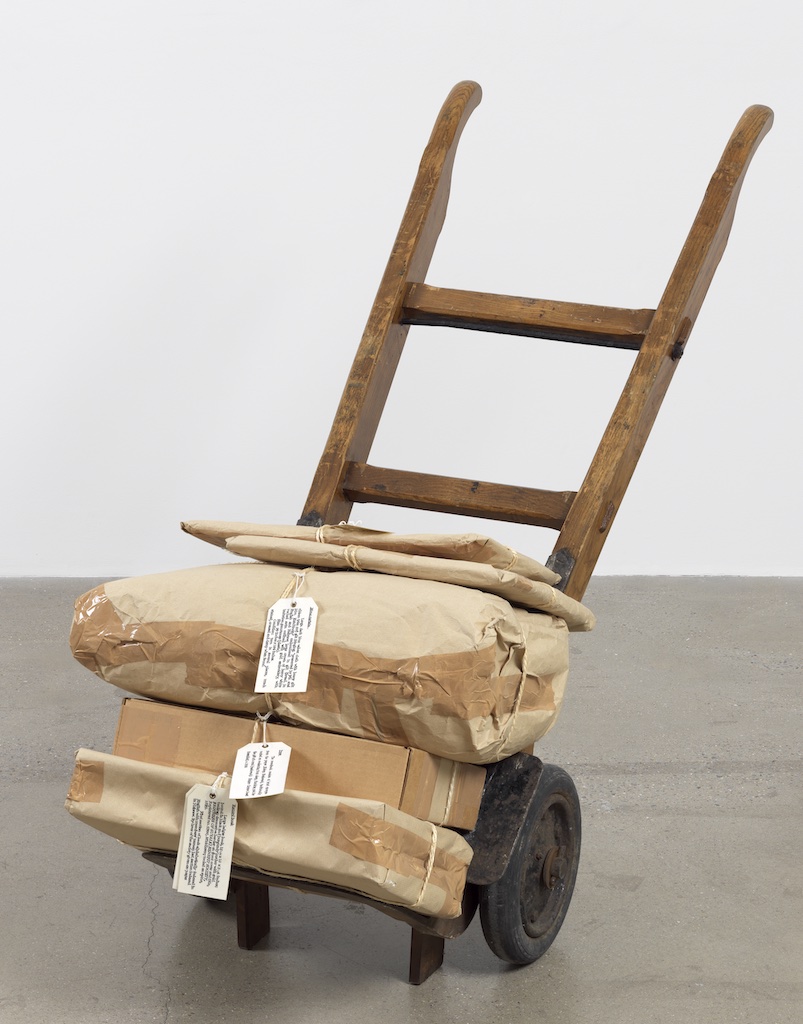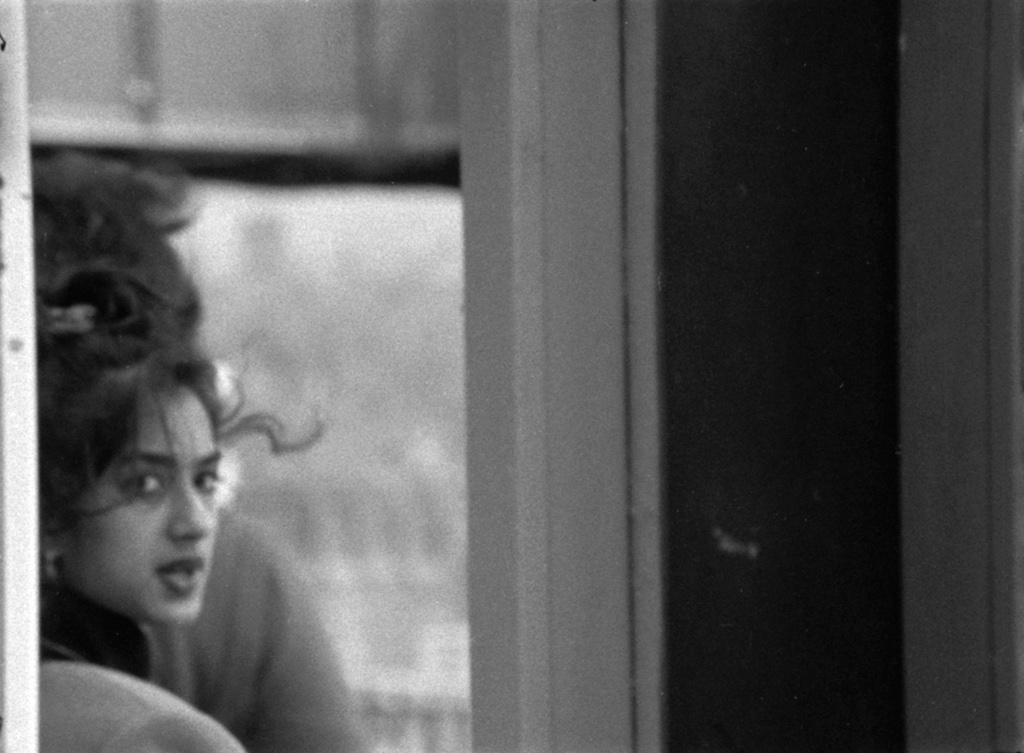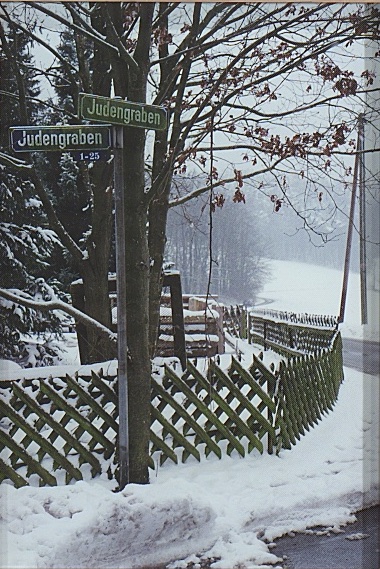Life is More Important than Art, Whitechapel Gallery review - themes of arrival, belonging and departure unite fascinating mixed show | reviews, news & interviews
Life is More Important than Art, Whitechapel Gallery review - themes of arrival, belonging and departure unite fascinating mixed show
Life is More Important than Art, Whitechapel Gallery review - themes of arrival, belonging and departure unite fascinating mixed show
The first show curated by the Whitechapel's new director Gilane Tawadros bodes well

Standing just inside the door of the Whitechapel’s downstairs gallery is a luggage trolley laden with parcels (pictured below, right).
“Bima curtain,” reads one label. “Large, dark blue velvet cloth with heavy gilt ribbon trim and gilt fringing. Condition: torn in several places, much stained, creased and damp when found.” The items were retrieved from the gutter by artist, Susan Hiller outside a demolished building in Whitechapel which had housed a small synagogue. Thousands of Jewish immigrants uses to live in this area and, in memory of the religious rituals these items once served, a recording can be heard of cantor Josef Rosenblatt singing a fragment of prayer.
 This powerful piece introduces Life is More Important than Art, a show of work that relates to the East End, Britain and the wider world. Also on show is a film and installation by Hiller which chart streets in Germany named after the Jewish communities that once lived there (pictured below left: installation detail).
This powerful piece introduces Life is More Important than Art, a show of work that relates to the East End, Britain and the wider world. Also on show is a film and installation by Hiller which chart streets in Germany named after the Jewish communities that once lived there (pictured below left: installation detail).
Static shots of unremarkable locations from cobbled alleyways to busy roads and market squares, show people going about their business in places called Judenstrasse, Judengasse, Judengang or Judenhof. The very ordinariness of each scene feels shocking; it’s as though the systematic elimination of the Jews from Nazi Germany has become little more than a distant memory which, relegated to history, has little bearing on the present.
The exhibition was curated by Gilane Tawadros, the Whitechapel’s new director, along with artist Janette Parris who shows pages from her forthcoming book This is not a Memoir. Parris is keeping the past alive in drawings of buildings that played an important part in her South and East London upbringing, but have since been demolished (main picture: West Ham United football stadium). They include the Ford plant in Dagenham where her father worked, Woodside Comprehensive where she learned to fence and compete against “posh white kids who I was allowed to stab” and the Boleyn Cinema where she got thrown out of Stanley Kubrick’s 2001: A Space Odyssey for being too rowdy. By charting her “journey to adulthood”, she also provides a record of the changing face of London; biography becomes local history. The catalyst for some of those changes has been new waves of immigrants. Osman Yousefzada’s parents came over from Pakistan. One would hope that after the upheaval of departure and the culture shock of arriving in a strange country, immigrants might gradually be able to settle and adjust and even attain some sense of belonging.
The catalyst for some of those changes has been new waves of immigrants. Osman Yousefzada’s parents came over from Pakistan. One would hope that after the upheaval of departure and the culture shock of arriving in a strange country, immigrants might gradually be able to settle and adjust and even attain some sense of belonging.
In An Immigrant’s Room of Her Own, 2018 Yousefzada creates a fanciful version of his mother’s bedroom. Tightly wrapped in clingfilm, a tower of stainless steel cooking pots dominates the room, while dotted over the carpet are dozens of smaller household items swathed in black plastic. It looks as if she has just arrived and has yet to unpack or is preparing for imminent departure. Nothing here suggests a sense of wellbeing, only a profound feeling of alienation and lingering anxiety.
 Fatima’s Letter, 1992 (pictured above) was shot almost entirely at Whitechapel tube station, a dismal spot that Alia Syed has transformed into a poetic evocation of arrival and departure. Grainy black and white footage of shadows, passengers glimpsed through carriage windows, doors sliding open and shut and trains gliding past creates a restless sense of endless coming and going.
Fatima’s Letter, 1992 (pictured above) was shot almost entirely at Whitechapel tube station, a dismal spot that Alia Syed has transformed into a poetic evocation of arrival and departure. Grainy black and white footage of shadows, passengers glimpsed through carriage windows, doors sliding open and shut and trains gliding past creates a restless sense of endless coming and going.
Meanwhile, a voice speaks in Urdu while subtitles recall chance encounters on the underground, and narrate a story of conquest in which women seduce sailors with sweetmeats and suffocate them with the drowsy scent of jasmine and musk. This heady mix of yearning, desire and home sickness is as intoxicating as the fragrances and as dreamy as the heat it evokes so beautifully.
Rana Begum’s installation is as sparse as Syed’s film is lush, yet it is just as evocative. Sections of chain link fence sprayed red and black hang in layers that pulsate in optical patterns as you walk past. The wire encloses nothing, nor does it protect any territory from intruders, yet associations with barricades and closed borders haunts this apparently innocent work.
Shot during the pandemic, John Smith’s film Citadel (pictured below) focuses on the view from his window of the office towers in the square mile. Extracts from Boris Johnson’s speeches in which he gives conflicting instructions about whether to stay at home or go to work, are accompanied by comparable shifts in the weather from sunshine to rain.
Glimpses of people variously exercising, cooking and working at home capture the longueurs of lockdown. Then, finally, as Johnson declares victory over Covid and asserts that “we are stronger and better than ever before”, the gleaming skyscrapers are wiped from view by a snowstorm. Business as usual has not been resumed, after all. Clever, funny and politically astute, the film is an ironic indictment of Johnson’s bluster and incompetence. “The difference between pessimism and optimism is constructing a good ending,” says Barbara Kingsolver, winner of the Women’s prize for fiction. And as if following her advice, the exhibition ends on a euphoric note with Mark Wallinger’s Threshold to the Kingdom 2000, which he filmed at City Airport in a single take. An endless stream of people pours through the doors of international arrivals. Seen in slow motion, weary travellers are transformed into pilgrims reaching the promised land – accompanied, on the soundtrack, by the celestial music of Miserere by Renaissance composer, Gregorio Allegri. It’s as if a choir of angels were welcoming the arrivals to Heaven. Ah, if only that were the case !
“The difference between pessimism and optimism is constructing a good ending,” says Barbara Kingsolver, winner of the Women’s prize for fiction. And as if following her advice, the exhibition ends on a euphoric note with Mark Wallinger’s Threshold to the Kingdom 2000, which he filmed at City Airport in a single take. An endless stream of people pours through the doors of international arrivals. Seen in slow motion, weary travellers are transformed into pilgrims reaching the promised land – accompanied, on the soundtrack, by the celestial music of Miserere by Renaissance composer, Gregorio Allegri. It’s as if a choir of angels were welcoming the arrivals to Heaven. Ah, if only that were the case !
- Life is More Important than Art at the Whitechapel Gallery until 17 September
- More visual arts reviews on theartsdesk
rating
Explore topics
Share this article
The future of Arts Journalism
You can stop theartsdesk.com closing!
We urgently need financing to survive. Our fundraising drive has thus far raised £49,000 but we need to reach £100,000 or we will be forced to close. Please contribute here: https://gofund.me/c3f6033d
And if you can forward this information to anyone who might assist, we’d be grateful.

Subscribe to theartsdesk.com
Thank you for continuing to read our work on theartsdesk.com. For unlimited access to every article in its entirety, including our archive of more than 15,000 pieces, we're asking for £5 per month or £40 per year. We feel it's a very good deal, and hope you do too.
To take a subscription now simply click here.
And if you're looking for that extra gift for a friend or family member, why not treat them to a theartsdesk.com gift subscription?
more Visual arts
 'We are bowled over!' Thank you for your messages of love and support
Much-appreciated words of commendation from readers and the cultural community
'We are bowled over!' Thank you for your messages of love and support
Much-appreciated words of commendation from readers and the cultural community
![SEX MONEY RACE RELIGION [2016] by Gilbert and George. Installation shot of Gilbert & George 21ST CENTURY PICTURES Hayward Gallery](https://theartsdesk.com/sites/default/files/styles/thumbnail/public/mastimages/Gilbert%20%26%20George_%2021ST%20CENTURY%20PICTURES.%20SEX%20MONEY%20RACE%20RELIGION%20%5B2016%5D.%20Photo_%20Mark%20Blower.%20Courtesy%20of%20the%20Gilbert%20%26%20George%20and%20the%20Hayward%20Gallery._0.jpg?itok=7tVsLyR-) Gilbert & George, 21st Century Pictures, Hayward Gallery review - brash, bright and not so beautiful
The couple's coloured photomontages shout louder than ever, causing sensory overload
Gilbert & George, 21st Century Pictures, Hayward Gallery review - brash, bright and not so beautiful
The couple's coloured photomontages shout louder than ever, causing sensory overload
 Lee Miller, Tate Britain review - an extraordinary career that remains an enigma
Fashion photographer, artist or war reporter; will the real Lee Miller please step forward?
Lee Miller, Tate Britain review - an extraordinary career that remains an enigma
Fashion photographer, artist or war reporter; will the real Lee Miller please step forward?
 Kerry James Marshall: The Histories, Royal Academy review - a triumphant celebration of blackness
Room after room of glorious paintings
Kerry James Marshall: The Histories, Royal Academy review - a triumphant celebration of blackness
Room after room of glorious paintings
 Folkestone Triennial 2025 - landscape, seascape, art lovers' escape
Locally rooted festival brings home many but not all global concerns
Folkestone Triennial 2025 - landscape, seascape, art lovers' escape
Locally rooted festival brings home many but not all global concerns
 Sir Brian Clarke (1953-2025) - a personal tribute
Remembering an artist with a gift for the transcendent
Sir Brian Clarke (1953-2025) - a personal tribute
Remembering an artist with a gift for the transcendent
 Emily Kam Kngwarray, Tate Modern review - glimpses of another world
Pictures that are an affirmation of belonging
Emily Kam Kngwarray, Tate Modern review - glimpses of another world
Pictures that are an affirmation of belonging
 Kiefer / Van Gogh, Royal Academy review - a pairing of opposites
Small scale intensity meets large scale melodrama
Kiefer / Van Gogh, Royal Academy review - a pairing of opposites
Small scale intensity meets large scale melodrama
 Jenny Saville: The Anatomy of Painting, National Portrait Gallery review - a protégé losing her way
A brilliant painter in search of a worthwhile subject
Jenny Saville: The Anatomy of Painting, National Portrait Gallery review - a protégé losing her way
A brilliant painter in search of a worthwhile subject
 Abstract Erotic, Courtauld Gallery review - sculpture that is sensuous, funny and subversive
Testing the boundaries of good taste, and winning
Abstract Erotic, Courtauld Gallery review - sculpture that is sensuous, funny and subversive
Testing the boundaries of good taste, and winning
 Edward Burra, Tate Britain review - watercolour made mainstream
Social satire with a nasty bite
Edward Burra, Tate Britain review - watercolour made mainstream
Social satire with a nasty bite
 Ithell Colquhoun, Tate Britain review - revelations of a weird and wonderful world
Emanations from the unconscious
Ithell Colquhoun, Tate Britain review - revelations of a weird and wonderful world
Emanations from the unconscious

Add comment